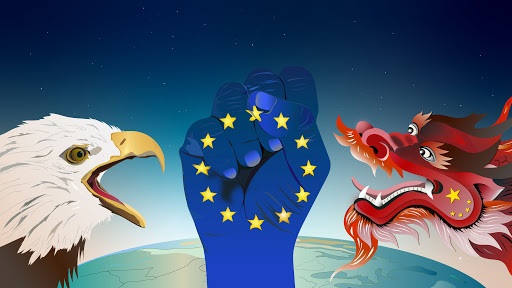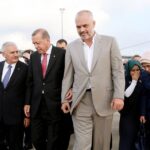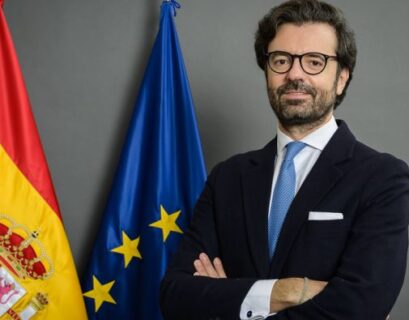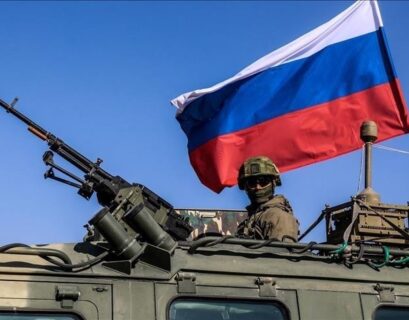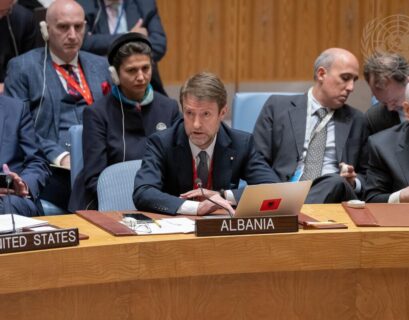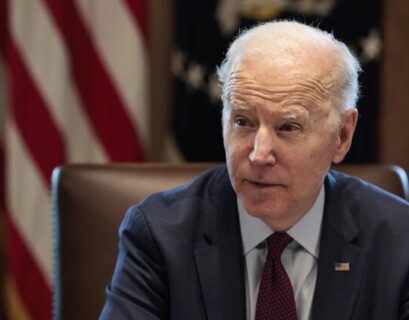JANUSZ BUGAJSKI
Europe has become the key battleground between the democratic “West” and the authoritarian “East.” Having triumphed in three European wars, two hot and one cold, the United States now faces a much more complex and prolonged conflict over the future of the old continent with its two chief global adversaries – Russia and China. Both are expansionist powers that threaten Western interests and both have focused their attention on subordinating Europe. Their ambitions highlight the need for maintaining a strong trans-Atlantic alliance.
While President Donald Trump has periodically downplayed the importance of NATO, without Allied solidarity in a range of contests, including military capabilities, cyberspace proficiency, economic development, and democracy protection, America will be increasingly exposed to hostile actions by Beijing and Moscow. If Europe becomes entrapped by China and divided by Russia than the U.S. will find itself increasingly isolated and vulnerable.
Russia’s Offensive
Moscow views NATO as a military and political threat that challenges its aspirations to dominate Europe’s east. It also perceives the EU as a key adversary in its broader pan-European ambitions. The EU’s standards of legality, transparency, and competition challenge Russia’s business model. Its political and human rights stipulations undermine the autocratic governance model preferred by Moscow among its neighbors, as it is easier to manipulate such alliances than dealing with democracies that regularly change governments. Hence Brexit and other challenges to the EU are welcomed in Moscow, as they divide the Union, encourage bilateral deals with Russia, limit further enlargement, and may curtail aspirations for EU membership among states adjacent to Russia. The Kremlin also seeks to drive a wedge between the “Anglo-Saxon” countries (the U.S., UK, and Canada) and continental Europe.
Both NATO and the EU are subject to intensive disinformation offensives emanating largely from Russian sources. NATO is depicted as an aggressive organization controlled by Washington and intended to spread American hegemony over Europe and threaten Russia’s state interests. With regard to the EU, Kremlin propaganda outlets and disinformation warfare tools focus on several themes: the allegedly degenerate nature of European liberalism; Western anti-religious and militant secularist campaigns; lack of sovereign state decision making; democratic paralysis and political chaos; recurring financial crises in the Eurozone; failed multiculturalism; uncontrolled immigration; the mishandling of the pandemic and slow economic recovery; and the looming disintegration of the Union after “Brexit.” These themes help Moscow stimulate and influence a “fifth column” of movements and parties in various parts of Europe.
Kremlin propaganda offensives include both psychological and policy components. The objective is not simply to divide Western societies, many of which are already politically polarized, or even to cultivate pro-Russian states. Its primary strategic goals are to paralyze democratic systems, fracture international institutions, and incapacitate national decision making particularly in countries that may challenge Russia’s neo-imperial aspirations.
While Soviet communism had a unitary ideological message in the global competition between two distinct socio-economic systems, Moscow’s contemporary narratives are “multi-ideological.” Its messages lack a singular precept or core value but are tailored and adapted for maximum impact among a diversity of targeted audiences. These propaganda narratives include at least three major message clusters – traditionalist, progressivist, and sovereigntist. The “traditionalist“ narrative is constructed to appeal to anti-liberal, Euro-skeptic, social conservative, and conventional religious constituencies in which Russia poses as the defender of traditional values. Conversely, EU and U.S. leaders and institutions are depicted as immoral, deviant, decadent, atheistic, and libertarian.
In this propaganda vortex, the principles of NATO and EU integration are condemned as being in direct confrontation with traditional social, familial, and religious values. Whereas the Soviet Union proclaimed itself as a revolutionary social force, Russia now poses to conservatives as a counter-revolutionary power that cherishes stability, continuity, faith, and tradition. Paradoxically, fundamentalist traditionalism in a multi-cultural context can also be presented as revolutionary by appealing to disaffected nationalist youth as well as to the conservative older generation seeking to restore an idealized bygone era.
A second Kremlin-generated narrative can be designated as “progressivist.” It is a more direct successor to Soviet propaganda and crafted to appeal to Western radical leftist, militant pacifist, anti-globalist, anti-militarist, anti-capitalist, anarcho-nihilist, and radical environmentalist movements. It depicts Russia as an inheritor of the USSR, a staunch bastion of anti-imperialism and an internationalist vanguard against American global hegemony and corporatist capitalism.
A third distinct Kremlin narrative bundle is the “sovereigntist.” It often overlaps with the traditionalist agitprop but focuses on the promotion of ethnic nationalism, regionalist separatism, xenophobic racism, protectionist nativism, and absolutist state sovereignty. Propaganda campaigns along the sovereigntist front are designed to fracture Western democracies by promoting domestic secessionist movements and inter-ethnic or inter-regional rivalries, while urging the dismantling of multi-national institutions such as NATO and the EU that supposedly threaten state independence.
The three major narratives are not simply fashioned to passively appeal to Western citizens. The main purpose is to agitate and marshal people to act upon their perceptions and convictions. Agitprop can influence party preferences, voting patterns, and policy choices. It may mobilize the young to engage in protest actions, join militant political organizations, or actively support single-issue causes. Propaganda of the word is combined with propaganda of the deed.
Kremlin-linked oligarchs fund organizations and campaigns in Western societies that reinforce Moscow’s three clusters of narratives. In the traditionalist package, a number of ultra-rightists and populist parties have reportedly received loans, PR assistance, and campaign funds from Russian sources. In return, party leaders applaud Russia’s foreign policy and heap praise on Vladimir Putin as a strong and effective leader. Connections are also pursued with conservative church organizations, including evangelical groups in the United States that believe and preach that Russia is a staunchly religious and family-oriented country.
In its progressivist agitprop, Russian sources have funded or given publicity to ultra-leftist parties and movements that can help challenge the policies of Western governments. They primarily target the younger generation who are more inclined to participate in anti-government protest actions or they seek to maneuver green movements and other causes to promote Kremlin interests. Sovereigntist agitprop has benefited from a bonanza of ethno-nationalist, separatist, and pro-sovereignty movements in Europe. “Brexit” provided a valuable opportunity to support ruptures in the EU and even the potential breakup of the United Kingdom. Regardless of their merits, Scottish and Catalan independence have either been encouraged or discredited by Russian propaganda activists with the aim of disrupting the domestic cohesion of Western countries.
Various liberation movements in Western states, including marginal separatists from Texas and California, have been invited to conferences in Moscow. Such gatherings also enable Russian officials to showcase and legitimize separatist groups in Georgia, Ukraine, and other neighboring states, while excluding autonomist, regionalist, and separatist organizations active in the Russian Federation. Moscow has also encouraged ethnic, racial, and religious disputes and fueled other socially divisive issues in the U.S. The eclectic nature of Putinist agitprop not only broadens its appeal but it also ensures that countering Moscow’s disinformation is more challenging than in Soviet times.
China’s Offensive
Although Vladimir Putin’s Russia remains the major near-term menace to Europe and trans-Atlanticism, China presents a more pernicious long-term threat. Russia is a revisionist aggressor focused on dividing and weakening the trans-Atlantic world, but its capabilities are declining and its internal contradictions escalating. China is a steadily advancing global competitor with a large economy and a more durable strategy to subvert Europe and surpass America.
Unlike Russia’s failing Eurasian Economic Union enforced over a handful of poor neighbors, China’s pan-continental ambitions are backed by substantial resources. Its expanding global role is not dependent on military power but on economic penetration that is leveraged for geopolitical advantage. It is steadily displacing the U.S. as the leading trading partner in a number of markets. Beijing is also intent on becoming a leader in advanced technology and higher-end industry. The Chinese regime has no design to impose its system of government on targeted states but to change global standards for trade and investment that will favor Beijing over its competitors. China’s global ambitions are encapsulated in its Belt and Road Initiative (BRI), involving more than 20 countries and aimed at developing land and sea corridors linking China with Central Asia, the Middle East, and Europe.
In exchange for economic investments, Beijing extracts diplomatic support for its policies and neutralizes criticisms of its abysmal human rights record. Beijing offers to boost poor economies but its investments entrap governments in perpetual debt. Similarly to Russia, China also blackmails or bribes vulnerable politicians and businessmen to favor Chinese geopolitical interests, conducts cyber penetration of Western institutions and companies, and is ramping up its disinformation warfare campaign against the U.S. and other democracies. China’s spying networks are also expanding and in particular penetrate the business sectors of Western states to capture industrial secrets.
Beijing has steadily increased its investments in many BRI countries and seeks to set global regulatory standards that will bestow advantages to Chinese enterprises and undermine the principles of free trade. Beijing has selected investment targets that are viewed as politically profitable inroads into the EU and has bought or invested in assets amounting to over $300 billion over the past decade. State-owned Chinese companies have purchased cargo terminals in the Mediterranean Sea and the Atlantic rim and control about a tenth of European port capacity. China is also financing the building of roads and railways throughout South East Europe. This forms part of Beijing’s plans to link China with Europe by sea, road, rail, and pipeline, and also a means to exert political influence.
In 2012, China initiated the its “17+1” project with 17 countries from Central-East Europe (CEE). In exchange for economic investments, Beijing seeks diplomatic support for its policies or to neutralize criticisms in international institutions. Its acquisition of the Greek port of Piraeus help ensure that Athens dilutes EU condemnations of China’s human rights record and its ambitions in the South China Sea. This formula is repeated across Europe with Beijing aiming to divide Europe from the U.S. and prevent the emergence of an anti-China front.
Beijing’s offers to boost local economies are difficult to resist, particularly by relatively poor countries along the BRI route in search of capital. China’s geo-economic strategy offers substantial financing but without the regulatory and legal standards on which Western institutions insist. Western states need to implement policies that can contain Chinese influence but without damaging the economic development of BRI countries. They must boost Western competitiveness in foreign markets while ensuring that China’s investments adhere to international standards and do not push governments into becoming permanent debtors.
Post-Pandemic Struggle
The COVID-19 pandemic is likely to be a strategic setback for China, particularly in its efforts to make further European inroads. The Chinese Communist Party suppressed early warnings about the virus amidst widespread concern that Beijing’s pressure compromised the World Health Organization’s response at a time when multilateral cooperation was desperately needed. China will also struggle to recover its high levels of economic growth while the world remains in a deep recession. The country is reliant on global demand for goods and a protracted recession will highlight its vulnerabilities. If the crisis continues over a year and the virus returns to China, this could even destabilize the communist regime.
NATO remains the primary trans-Atlantic pillar that counters Europe’s potential subordination to Russian or Chinese interests. It has acted in unison to fortify its eastern flank and has developed a broad arsenal of deterrents and not only in the military arena. It has established several Centers of Excellence in Europe that rigorously monitor and analyze a range of threats – from terrorism to cyber and disinformation. Such work is indispensable for responding to the eclectic forms of contemporary warfare. NATO is the key institution that upholds American geopolitical influence throughout Europe and projects these to nearby regions while adapting to counteract new threats.
Where economics undergirds security, Western allies must re-evaluate their economic links with Beijing in order to protect their national and collective interests. In the wake of the pandemic, several American and European companies are likely to vacate Chins and seek more reliable partners closer to home. Growing suspicion over China’s economic and political objectives should also impact on Beijing’s BRI initiative. The EU must become more effective in screening foreign investment, having already declared China a “systemic rival” and “strategic competitor,” and boost Western investments in struggling economies. Given the escalating global crises in the wake of the pandemic, a rudderless Western alliance will become much more vulnerable to both Russian and Chinese subversion. This could weaken trans-Atlantic unity, provoke renewed conflicts in Europe, embolden Beijing’s and Moscow’s ambitions in other critical regions, and endanger American security.
However, the strategic tables can be turned on the West’s two major adversaries if there is vision and determination in the White House, particularly as both Russia and China have their own deep-rooted frailties. In the case of Moscow, a strategy must be developed to divert its attention away from external offense to internal defense. Russia has numerous economic, social, political, cyber, ethnic, religious, and regional vulnerabilities that have been starkly revealed by the recent collapse of oil prices and the spreading pandemic. China could also undergo economic contraction and a potential loss of markets across Europe and Eurasia as a consequence of the pandemic. This can generate social and political struggles that preoccupy the ruling Communist Party. Washington must also devise ways of driving wedges between Moscow and Beijing, as their looming competition over Central Asia and Russia’s East Asian provinces can seriously damage their strategic partnership against the West.
Janusz Bugajski is a Senior Fellow at the Center for European Policy Analysis (CEPA) in Washington DC. His recent book, co-authored with Margarita Assenova, is entitled Eurasian Disunion: Russia’s Vulnerable Flanks, Jamestown Foundation, Washington DC.


